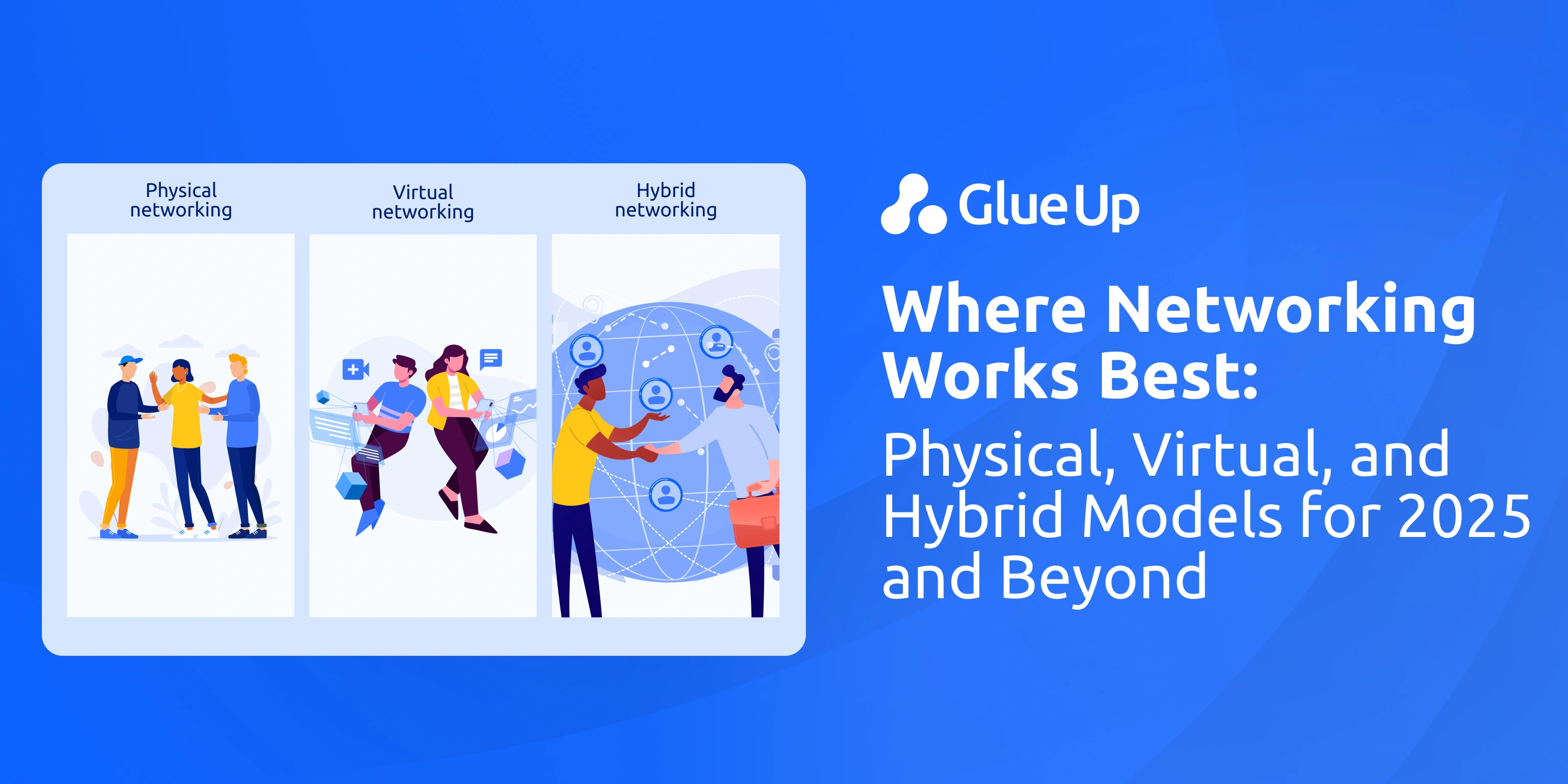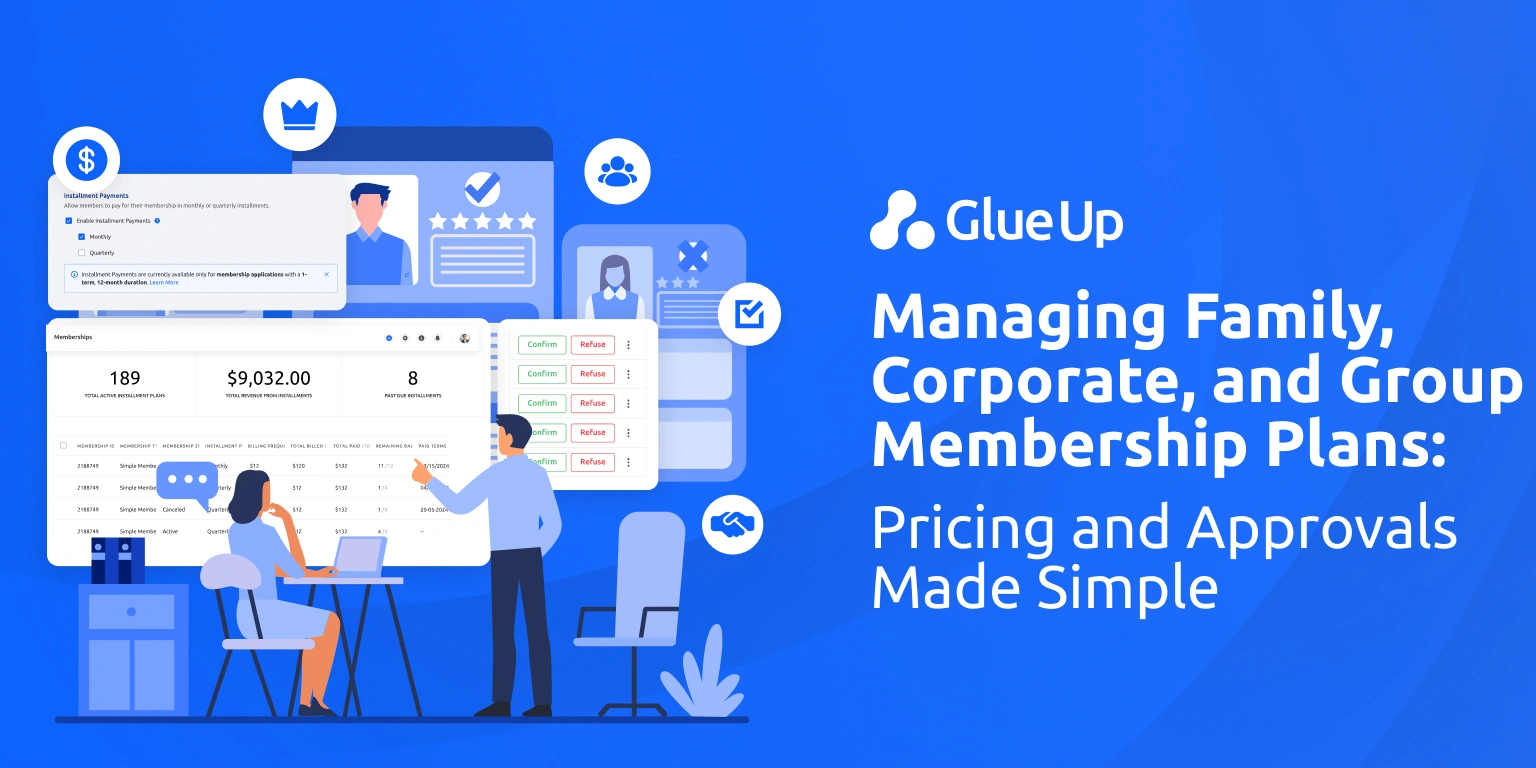
Networking is at the heart of why people join associations. A recent EventMB survey found that 82% of event planners believe networking is the primary reason attendees attend their events. That makes choosing between virtual vs physical vs hybrid networking crucial for membership-based organizations.
Each format influences how members connect and the value they take away. So, you must choose carefully to ensure your events strengthen relationships, expand reach, and support your mission.
In this article, we'll compare the three approaches, explore when each one makes sense, and highlight how Glue Up's event management software helps associations and chambers host networking events that truly deliver.
And if you're new to Glue Up, feel free to book a demo and see how our all-in-one event management software for associations helps you centralize registrations, automate routine processes, and deliver events that members remember.
Key Takeaways
Physical networking builds trust and community but comes with higher venue, travel, and accommodation costs.
Virtual networking increases accessibility, reduces costs, and scales quickly, but often lacks the spontaneity of in-person interaction.
Hybrid networking combines the reach of virtual with the physical depth, though it requires careful planning and resources to execute well.
Associations should choose formats based on their goals: depth (physical), reach (virtual), or flexibility (hybrid).
Glue Up's event management software supports all three formats with tools for registration, engagement, integrations, and reporting in one place.
First Things First: Why Networking Formats Matter in 2025
Twenty years ago, associations relied almost entirely on in-person networking events—think conference halls, name badges, coffee breaks. Virtual events existed, but they mostly lacked the spontaneity and trust that fuel member connections. Then COVID-19 happened, and everything changed.
However, according to a 2025 report, six in ten associations expect virtual and hybrid events to remain a significant part of their event strategy, and 15% of North America's events are projected to be hybrid in 2025.
Here's why this matters to your association's leadership:
Physical formats offer face-to-face engagement and trust-building that can't be replaced, no matter what platform you use or how organized you are.
Virtual formats expand access, cut costs (often by 75%), and boost attendance and reach
Hybrid formats let you serve all members, but only with careful planning and the right tools.
If you think about it, the debate around virtual vs physical vs hybrid networking is really about experience vs cost-effectiveness vs flexibility. However, no matter which format you choose, you must ensure five things even after the side-by-side comparison:
Accessibility – members should be able to join and engage without unnecessary barriers.
Engagement – events must create real opportunities for interaction, not just passive attendance.
Relevance – the networking opportunities should connect directly to members' goals.
Scalability – your chosen format should support growth without overwhelming resources.
Measurability – you need data to prove the value of the networking experience to your board and members.
What is Physical Networking?
Let's start with the most traditional format: in-person networking. For decades, this has been the foundation of association events—conferences, annual meetings, and local chapter gatherings where members shake hands, exchange cards, and build in-person relationships.
"In the context of associations, physical networking means bringing members together in the same room to exchange knowledge, build trust, and strengthen professional relationships through direct interaction. It often includes receptions, breakout discussions, roundtables, or informal hallway conversations at larger conferences."
Benefits of Physical Networking
Even today, in-person events offer advantages that no other format can fully match. A Forbes Business Council survey found that 95% of professionals say face-to-face meetings are essential for building long-term relationships. For associations, this potentially translates directly into member retention and satisfaction with key benefits like:
Stronger trust and credibility through face-to-face interactions.
Deeper engagement during live events such as Q&A sessions, workshops, and panel discussions.
High-quality event experience that reinforces the value of membership.
Traditional networking formats like receptions and roundtables that remain familiar and effective.
Opportunities for sponsors and partners to connect directly with attendees in a physical space.
Drawbacks and Limitations of Physical Networking
While physical networking remains powerful, it also comes with challenges that associations can't ignore:
High costs for venue rentals, catering, and logistics.
Travel and accommodation expenses for both members and staff.
Geographical limitations that restrict participation to local or regional members.
Time commitment required from attendees, making it less attractive for those with busy schedules.
Unexpected risks, such as disruptions from health crises (e.g., the COVID-19 pandemic), travel restrictions, or security issues.
For associations, the challenge is not whether physical networking works—it clearly does. The real question is how to balance these benefits with formats that offer greater reach and cost-effectiveness.
What is Virtual Networking?
Although virtual networking has been around since the early 2000s with the rise of online forums and early web conferencing tools, it became mainstream in 2020 when the COVID-19 pandemic forced associations to move events online.
What was once considered an alternative quickly became the only way to keep members connected. Today, virtual networking remains a vital format for associations that want to engage their communities without the costs of physical gatherings.
"In the context of associations, virtual networking means bringing members together digitally to interact through virtual conferences, chat rooms, breakout sessions, and online Q&A. Instead of traveling to a venue, members join from anywhere with an internet connection, making it easier for geographically dispersed audiences to participate."
Benefits of Virtual Networking
Virtual events offer associations clear advantages that are difficult to match in person. Studies show that attendance at virtual events can be two to three times higher than at in-person events because members don't face travel or accommodation costs.
Key benefits include:
Greater accessibility for members who face geographical limitations.
Lower costs compared to venue rentals, catering, and travel expenses.
Scalability to host hundreds or even thousands of virtual attendees without additional overhead.
Flexible event formats, such as webinars, virtual Q&A sessions, and online workshops.
More measurable data through digital platforms that track attendance, engagement, and interactions.
Drawbacks and Limitations of Virtual Networking
At the same time, virtual networking has its weaknesses:
Weaker relationship-building compared to traditional in-person formats.
Limited spontaneity since casual hallway or coffee-break conversations are difficult to replicate online.
Technology barriers, such as poor internet connections or a lack of familiarity with platforms.
Virtual fatigue when members attend too many online events without meaningful engagement.
Less sponsor visibility compared to physical events, where booths and signage play a bigger role.
For associations, virtual networking offers reach and cost-effectiveness, but it requires intentional design to ensure members don't just attend, but connect.
What Is Hybrid Networking?
Think of hybrid networking as the best of both worlds. Members can choose whether to attend in person at a venue or join virtually from anywhere, allowing associations to serve both audiences simultaneously. This approach became widespread in the "new normal" after COVID-19, when organizations must provide choice and flexibility to keep participation high.
"Hybrid association networking events offer the flexibility to deliver the experience of face-to-face interactions while ensuring cost-effectiveness and accessibility for those who cannot travel. A hybrid event might feature live keynotes and receptions on-site, while remote members participate through live streams, chat tools, and virtual Q&A sessions."
Benefits of Hybrid Networking
Hybrid networking allows associations to maximize engagement while reducing barriers to participation. Key benefits include:
Flexibility for members who want either in-person or virtual attendance
Expanded reach without excluding geographically distant members
Cost-effective participation for those avoiding travel and accommodation
Inclusivity for members with health, mobility, or scheduling challenges
Richer engagement data through integrated virtual platforms
For associations, these benefits make hybrid networking a powerful way to balance reach with meaningful engagement.
Drawbacks and Limitations of Hybrid Networking
Like the combined benefits, the risks and challenges of hybrid events also amplify. Associations must be ready to manage:
More complex planning and execution with two formats running in parallel
Higher costs if both on-site and virtual infrastructure aren't managed carefully
Uneven experiences if virtual attendees feel secondary to in-person participants
Greater reliance on technology to avoid disruptions
These challenges mean you must approach hybrid networking with precise planning, the right tech stack, and a focus on designing equal experiences for all participants.
Virtual vs Physical vs Hybrid Networking: When to Choose Each Format
From what we've read so far, the question isn't which format is better—it's which one serves your members best at a given time. Each has a place in your association event strategy. Here's how to think about it:
When to Choose Physical (In-Person) Networking
Go in-person when your goal is depth of connection. Annual conferences, leadership retreats, and chapter meetings thrive in this format because members can build trust over coffee breaks, share ideas in workshops, and meet sponsors face-to-face.
For example, if your association is onboarding new members or celebrating a milestone anniversary, an in-person event reinforces the sense of community that virtual events can't match.
When to Choose Virtual Networking
Choose virtual when accessibility and scale matter most. Virtual events work well for professional development sessions, policy updates, or global networking where travel isn't practical. Many associations use webinars for continuing education credits or host virtual town halls to include members who otherwise couldn't attend due to geographical limitations.
This format is also useful for quick sponsor showcases or Q&A sessions, where members want direct information without the added cost of travel.
When to Choose Hybrid Networking
Hybrid is the right choice when you need the best of both worlds—reach and impact. Large annual conferences, industry expos, and annual general meetings benefit from this format because you can welcome local members on-site while still engaging remote participants online.
Associations often use hybrid to balance sponsor expectations too: on-site exhibitors connect with in-person attendees, while digital tools extend visibility to a virtual audience. If inclusivity is a priority (ensuring no member feels left out), hybrid is often the strongest option.
How Glue Up Supports Every Networking Format
Regardless of your association's format, Glue Up's association management software supports the entire process—from registration to engagement and post-event reporting. The platform gives you flexibility while keeping everything centralized.
Supporting Physical (In-Person) Events
For in-person networking, Glue Up helps associations manage the logistics that can otherwise drain staff time:
Online registration and ticketing integrated with your membership database.
Cvent integration for large-scale conferences and venue-based events, making it easier to handle seating, badging, and complex schedules.
Mobile check-in through the Glue Up Organizer App, reducing wait times at the door.
On-site engagement tools like QR code badges, personalized agendas, and automated reminders.
Post-event reporting so you can track attendance, no-shows, and ROI for sponsors.
Supporting Virtual Events
When your association hosts virtual networking, Glue Up integrates with the platforms members already use:
Zoom integration for webinars, panels, and workshops, with single sign-on from the registration page.
Automated event reminders and branded confirmation emails.
Interactive features such as polls, live chat, and virtual Q&A sessions built into the platform.
Post-event recordings shared automatically to registered attendees.
Engagement analytics that show who attended, how long they stayed, and where they participated most.
Supporting Hybrid Events
Hybrid events require both sets of tools—physical and virtual—and Glue Up combines them into one workflow:
Unified registration pages where members choose whether they'll attend in person or online.
Segmented communications allow physical attendees to receive venue information while virtual attendees get streaming links.
Hybrid agenda management to ensure sessions are synchronized across both audiences.
Sponsor visibility tools that allow in-person booths and digital banners to reach both audiences.
Centralized reporting so associations can measure attendance, engagement, and sponsor ROI across formats.
We don't decide the format for you. Our platform only gives you the tools to deliver whichever format your members need. Whether that means a face-to-face conference, a Zoom-powered webinar, or a hybrid annual meeting, you'll have one platform to keep everything consistent and measurable.
Bringing It All Together
At the end of the day, networking is why many members join your association in the first place. Whether it happens through face-to-face conversations, virtual Q&A sessions, or hybrid formats that bring both worlds together, your job is to make sure those connections actually happen.
What matters most isn't the format itself but the experience: members should feel included, engaged, and able to build meaningful relationships no matter how they participate. That's where the right tools make a difference.
At Glue Up, we know your team didn't sign up to chase registrations, manage spreadsheets, or juggle multiple platforms. You're here to build a community. Our event management software helps you centralize registrations, automate communications, and deliver consistent networking experiences across physical, virtual, and hybrid formats.
If you're ready to simplify your events and give members more ways to connect, we'd gladly show you how. Book a demo and see how Glue Up can help your association strengthen connections and prove the value of membership in every event you host.
Frequently Asked Questions
Is Virtual Networking as Effective as In-Person Networking?
Not always in the same way. Physical events create stronger trust through face-to-face interactions, while virtual events expand reach by removing geographical limitations. Associations often find virtual works well for professional development and quick updates, while in-person excels at relationship-building and sponsor visibility.
What Are the Advantages of Hybrid Networking?
Hybrid events combine virtual accessibility with the in-person depth. Members can attend physically or virtually, making events more inclusive. Hybrid formats are also useful for large annual meetings or conferences where your association doesn't want to exclude members who can't travel.
Do Hybrid Events Cost More Than Physical Ones?
They can, but not always. While hybrid requires investment in on-site logistics and virtual technology, it can also be cost-effective because more members attend, and sponsors gain visibility with two audiences. The key is smart event planning and execution—avoiding duplication and using integrated tools.
Which Format Works Best for Professional Associations?
There's no one answer. Associations focused on member experience and deep connections often prioritize physical events. Those aiming to expand access across geographies rely on virtual formats. Associations increasingly turn to hybrid models to balance inclusivity, cost, and engagement.
How Can Associations Improve Engagement in Virtual and Hybrid Events?
Design matters. Use features like live polls, Q&A sessions, and breakout discussions to recreate some interaction that happens naturally in person. Associations should also plan communications carefully so virtual and physical attendees feel equally included before, during, and after the event.



